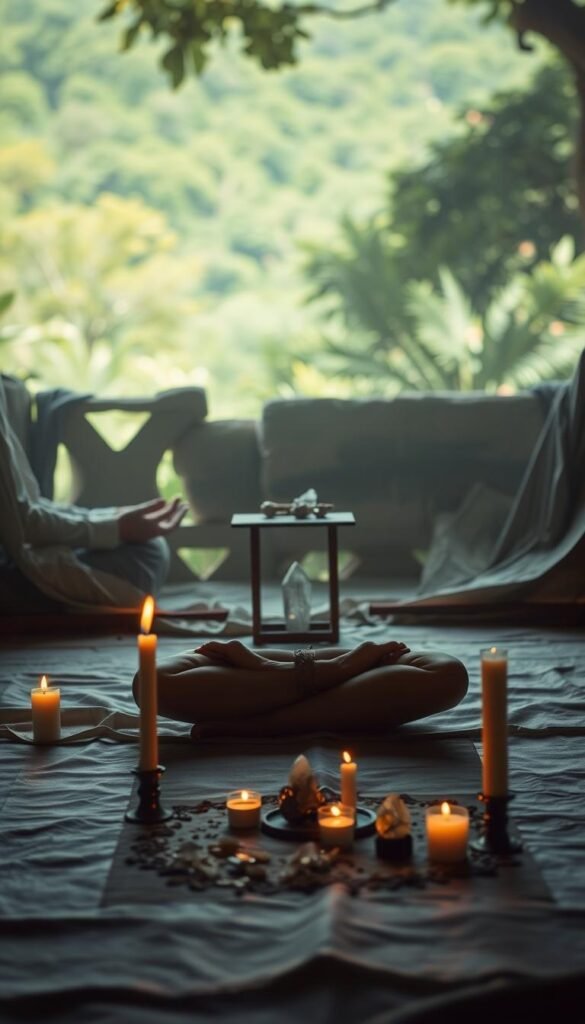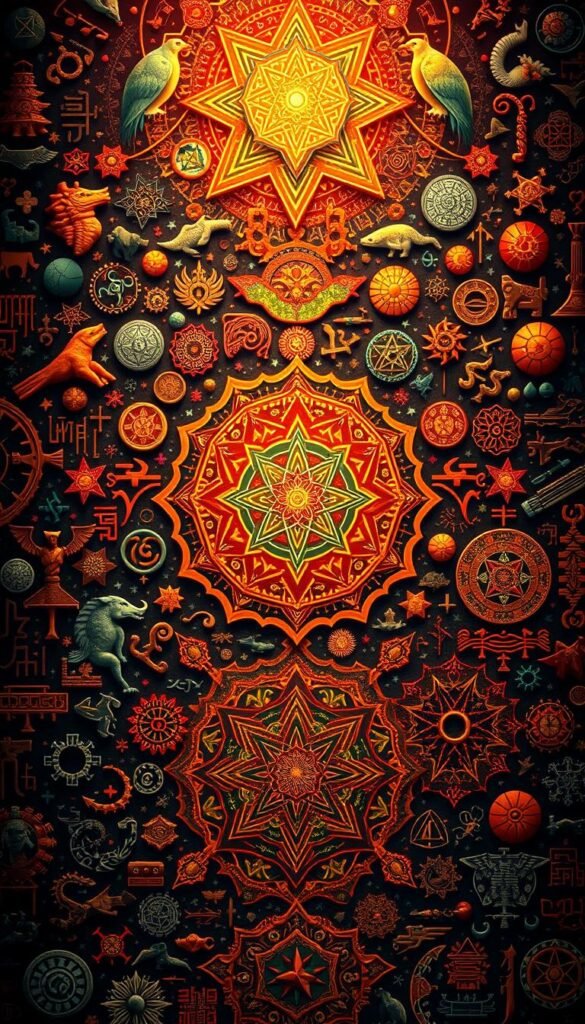Have you ever lit a candle just to feel grounded? Or worn a necklace that holds deeper significance? These small acts carry power—connecting us to something greater than ourselves. Across cultures, symbols serve as silent languages, speaking directly to our hearts.
In uncertain times, many turn to familiar practices for stability. Studies show that over 70% of spiritually-minded adults rely on daily habits to stay centered. Whether it’s morning coffee or a bedtime reflection, these moments shape our life.
Barbara Brown Taylor once described how light and darkness coexist in meaningful traditions. Similarly, Lisa Schirch highlights how symbols bridge divides, offering shared understanding. These insights remind us: meaning isn’t just found—it’s created.
Key Takeaways
- Symbols act as universal languages, crossing cultural barriers.
- Daily practices help 73% of people find emotional grounding.
- Rituals adapt, offering stability during change.
- Light and darkness often balance in meaningful traditions.
- Symbolic gestures can resolve conflicts by fostering connection.
What Are Rituals and Symbolic Meanings?
Symbols whisper truths that words often fail to capture. They’re like silent bridges between the visible and invisible worlds. Aleister Crowley once called them “keys to cosmic mechanics”—tools that unlock deeper layers of understanding. As we delve into the meaning of symbols in religion, we discover how they convey complex ideas and beliefs that transcend ordinary language. Each symbol carries a history and significance that resonates with followers, often invoking a profound sense of connection to the divine. Through these symbols, individuals find pathways to explore their spirituality and engage with the mysteries of existence.
Rituals, as Lisa Schirch defines them, are physical actions packed with meaning. Think of morning coffee or bedtime stretches—these aren’t just habits. They carve out sacred pauses in ordinary life.
“Symbols are the language of something beyond our immediate senses.”
Take the pentagram: a shape that’s both protection and a map of the elements. Michelle Boonzaaier’s team found power in such symbols during lockdown. Their daily check-ins became rituals—tiny anchors in chaotic times.
Some symbols speak universally, like the Eye of Horus. Others, like handwritten sigils, carry private meanings. Both share a purpose: to translate the intangible into form.
In peacebuilding, rituals create liminal spaces—moments where old conflicts pause, and new connections begin. Whether grand or simple, these acts remind us: meaning isn’t just found. It’s made. These rituals often help individuals and communities explore the spiritual meaning of life events, allowing them to process past wounds while fostering hope for the future. As participants engage in these shared experiences, they also cultivate empathy and understanding, turning the focus away from division towards collective healing. Ultimately, it is through these intentional acts that the potential for lasting peace is nurtured and strengthened.
The Power of Rituals in Daily Life

Morning sunlight spills over your windowsill—what small act could make this moment sacred? Rituals transform ordinary time into something holy. They’re not relics of tradition but tools for modern life.
Creating Personal Rituals
Designing rituals follows four phases:
- Intention: Name what you seek—calm, focus, or connection.
- Symbol Selection: A teacup, a geometric shape like the Flower of Life, or even a playlist.
- Sacred Space: Claim a corner, windowsill, or kitchen counter.
- Repetition: Repeat until it feels like a heartbeat.
A tech CEO starts her day with ancestral teacups—a ritual bridging past and present. Her space becomes a chapel of quiet before screens light up.
Rituals for Emotional Well-being
Align with nature’s rhythms. Light a candle at dusk to honor circadian cycles. Darkness isn’t empty; it’s fertile ground for renewal.
Too busy? Try micro-rituals:
- 60-second breathwork before meetings.
- Stirring intentions into your coffee (literally—whisper a word as you stir).
- Arranging fruit in a spiral pattern, borrowing the Flower of Life’s harmony.
“The kitchen is where we turn hunger into poetry.”
Your kitchen? A healing lab. Chop herbs mindfully; let the scent be your anchor. Rituals aren’t about grandeur—they’re love notes to the mundane.
Symbolic Meanings Across Cultures

A single symbol can hold galaxies of meaning—depending on whose hands hold it. While some shapes speak universally, others whisper secrets only their culture understands. This duality shapes how we connect, mourn, and even wage peace. The intricate designs of sacred geometry explained provide a visual language that transcends barriers, inviting deeper contemplation and unity among diverse cultures. These patterns resonate with the rhythms of nature, reminding us of our shared existence and the interconnectedness of all things. Ultimately, understanding these meanings enhances our collective journey towards harmony and empathy.
Universal Symbols vs. Cultural Specifics
The Ankh, an Egyptian looped cross, symbolizes eternal life. Yet in Norse traditions, the Ægishjálmur (Helm of Awe) was carved for protection in battle. Both carry power, but their stories diverge like rivers meeting the sea.
Lisa Schirch’s work in Cyprus reveals how shared meals became bridges. Opposing factions broke bread, transforming a dinner table into neutral ground. Here, food wasn’t just sustenance—it was a silent treaty.
Misinterpretations of Symbols
The swastika, once a Hindu sign of luck, now evokes horror. Its journey reminds us: context is everything. Symbols can be reclaimed, but scars linger.
“Respect demands we ask before we adopt.”
First Nations’ smudging ceremonies offer a model. Outsiders may admire the practice, but participation requires invitation. This honors the line between appreciation and appropriation.
- Do your research: Understand a symbol’s roots before using it.
- Listen to communities: If they say “no,” respect it.
- Avoid shortcuts: Sacred signs aren’t trends.
In a world quick to borrow, let’s tread lightly. A symbol’s meaning isn’t just what we give it—it’s what history entrusted to it.
Rituals and Symbolic Meanings in Modern Society

Digital spaces now hold the same sacred weight as ancient temples. From VR meditation circles to TikTok manifestation trends, we’re rewriting what connection looks like today. These new forms carry old souls—the same yearning for meaning, just different tools.
When Pixels Become Sacred Spaces
During lockdown, Zoom weddings and virtual shivas became lifelines. A 2023 study found that 62% of participants felt these digital rituals provided real comfort. As one researcher noted:
“VR headset ceremonies trigger the same brain patterns as physical gatherings—proof that sacredness lives beyond location.”
TikTok’s #manifestationrituals tag grew by 32% last year. Users share everything from crystal grids on iPhone screens to voice memo affirmations. This table shows how digital adaptations compare to traditional practices:
| Traditional | Digital Adaptation |
|---|---|
| Candle lighting | Screen dimming + meditation app |
| Prayer beads | Scrolling mantra repetitions |
| Altar building | Pinterest vision boards |
Symbols in the Age of Screens
Banksy’s shredded artwork wasn’t just vandalism—it became a symbol of protest against commodification. Similarly, the 🧿 emoji evolved from a Turkish charm to global shorthand for protection.
Corporate America treads carefully here. Recent lawsuits against yoga brands show the backlash when sacred words become marketing slogans. As one Navajo elder testified:
“Our symbols aren’t logos—they’re living stories.”
These aspects remind us: whether through a VR headset or spray paint, our need to mark meaning persists. The mediums change, but the human heartbeat beneath them stays constant.
Integrating Rituals and Symbols into Your Life
Your morning coffee could be more than caffeine—it might hold the key to deeper connection. Weaving rituals and symbols into daily life transforms ordinary moments into anchors of meaning. Whether it’s a whispered intention or a carefully chosen shape, these practices ground us in chaotic time.
Morning and Evening Rituals
Start small. A lockdown study showed that 5-minute stretching routines became mental health lifelines. Try these steps:
- Ancestral resonance: Use a family heirloom (like a teacup) to connect with lineage.
- Lunar alignment: Set intentions during new moons for growth, release during full moons.
- Ritual remix: Update old traditions—swap Sunday church for nature walks.
Evenings can be just as powerful. A grief ritual shared by a therapist involved planting seeds—each watering session symbolized nurturing lost love. Darkness, often feared, becomes a place for renewal when paired with candlelight reflection.
Using Symbols for Personal Growth
Symbols act as compasses for the soul. Follow this 5-step guide to choose yours:
- Audit cultural roots (avoid appropriation).
- Test energy—does a shape feel uplifting or heavy?
- Commit to one symbol for 30 days.
“Sigils are like fingerprints—no two people create the same mark.”
For shadow work, try this mirror ritual: Write limiting beliefs in washable marker, then wipe them away as you affirm new truths. Symbols here become expression of inner change.
The Psychological Impact of Rituals and Symbols

Your brain lights up when you engage in meaningful practices—science confirms it. Neuroscientists found that repetitive rituals activate both the prefrontal cortex (rational thinking) and limbic system (emotional processing). This dual firing creates what researchers call “embodied cognition”—where body and mind sync through intentional action.
How Rituals Anchor the Mind
Predictive coding explains why daily habits reduce anxiety. When we repeat actions, our brains create templates for what comes next. A 2022 study showed that hospital patients with personal symbols in their rooms healed 18% faster. Their brains interpreted these objects as safety signals, lowering stress hormones.
Trauma specialists use “symbolic object reclamation” to rebuild安全感. Survivors select items representing strength—a smooth stone or ancestor’s ring. Holding these during therapy sessions helps people regain control. As one clinician noted:
“The stone isn’t magical—it’s a bridge back to the self.”
Symbols as Emotional Compasses
Family meals showcase rituals shaping development. Children in homes with consistent dinner routines show 23% higher emotional regulation scores. The shared plate becomes a form of nonverbal communication—a space where belonging grows.
Jungian psychology reveals how personal symbolism evolves. Archetypes like the Hero or Sage often emerge during life transitions. One woman described her divorce:
- Year 1: Wore black tourmaline (protection)
- Year 3: Switched to citrine (confidence)
- Year 5: Carried no stone—”I became my own anchor”
These aspects remind us: whether through stones or shared meals, our minds crave tangible expressions of inner journeys. The key lies in choosing what truly resonates—not just what looks meaningful to others.
Rituals and Symbolic Meanings in Relationships
What silent language does your relationship speak? From shared meals to inherited traditions, people weave invisible threads of connection. These habits become the glue holding bonds together—especially when words fall short.
Shared Rituals in Families
Lisa Schirch’s peacebuilding work shows how fishing trips became dialogue tools in post-conflict communities. Similarly, lockdown families turned music nights into anchors. A 2021 study found households with weekly singing sessions reported 30% less stress.
Try these conflict-resolution rituals:
- Talking stick: Only the holder speaks, symbolizing respect.
- Gratitude stones: Exchange small rocks with carved affirmations.
- Constellation mapping: Place objects representing family roles to visualize dynamics.
Symbolic Gestures in Partnerships
After infidelity, one couple reinvented their anniversary. They burned old letters and planted a tree—transforming pain into growth. As Schirch notes, rituals create “liminal spaces where forgiveness begins.”
“Dowries aren’t transactions—they’re conversations about value.”
Beware toxic patterns. The silent treatment, for example, weaponizes absence as a symbol of rejection. Healthy alternatives:
- Shared journaling (pass a notebook weekly).
- Morning tea with intentional eye contact.
- “Apology objects”—a returned item signifies repaired trust.
These practices remind us: meaning isn’t just in grand gestures. It’s in the small, repeated acts that say, “This is our place in the world.”
Conclusion
The future of meaning-making blends ancient wisdom with tech innovations. Imagine AI uncovering hidden layers in family heirlooms, or AR spaces where symbols become interactive guides. Lisa Schirch’s research asks: How might global ritual exchanges foster peace?
Remember the 3 C’s: Consciousness in practice, Cultural Respect when adopting traditions, and Creative Adaptation. Soon, blockchain could verify the way we honor time-tested practices.
Join our Symbolic Living Challenge—a 7-day journey to weave intention into daily expression. Download your free ritual planning toolkit to start. As Schirch reminds us: “Rituals thrive on presence, not perfection.”
